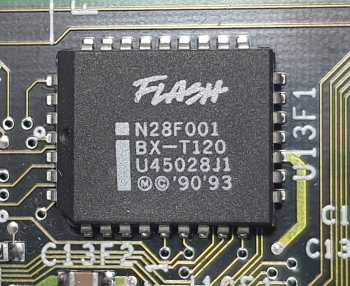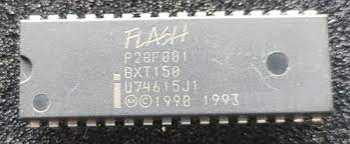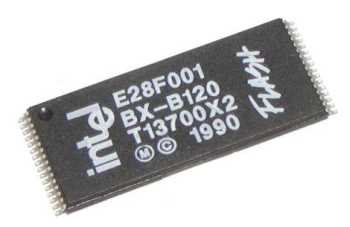Also known as:
- Intel N28F001BX-T
- Intel P28F001BX-B
- Intel 28F001BN-T
- Intel 28F001BN-B
- Intel E28F001BX-B
Description:
Overview
The Intel 28F001BX series is a family of 1-Mbit (128K x 8) non-volatile flash memories organized as 131,072 bytes of 8 bits, offering cost-effective and innovative alternatives to EPROM, EEPROM, and battery-backed static RAM. The series provides simplified write, block erase, high-performance read, and standard processor interfaces, making it suitable for various applications.
Key Features:
- High-Integration Blocked Architecture:
- One 8 KB Boot Block with Lock Out
- Two 4 KB Parameter Blocks
- One 112 KB Main Block
- 100,000 Erase/Program Cycles Per Block
- Simplified Program and Erase:
- Automated Algorithms via On-Chip Write State Machine (WSM)
- SRAM-Compatible Write Interface
- Deep Power-Down Mode:
- 0.05 mA ICC Typical
- 0.8 mA IPP Typical
- 12.0V ± 5% VPP
- High-Performance Read:
- 70/75 ns, 90 ns, 120 ns, 150 ns Maximum Access Time
- 5.0V ± 10% VCC
- Hardware Data Protection Feature:
- Erase/Write Lockout during Power Transitions
- Advanced Packaging, JEDEC Pinouts:
- 32-Pin PDIP
- 32-Lead PLCC, TSOP
- ETOX II Nonvolatile Flash Technology:
- EPROM-Compatible Process Base
- High-Volume Manufacturing Experience
- Extended Temperature Options
The Intel 28F001BX series is available in 32-pin plastic DIP, 32-lead PLCC, and 32-lead TSOP packages, conforming to JEDEC standards for byte-wide EPROMs. The series includes two variants, 28F001BX-B and 28F001BX-T, tailored for microprocessors and microcontrollers that boot from low memory and high memory, respectively. Both variants feature an integrated command port, state machine for simplified block erasure, and byte reprogramming. The boot block section includes a reprogramming write lockout feature to guarantee data integrity. The devices also support low power consumption and deep power-down mode, ideal for laptop computers, handheld instrumentation, and other low-power applications.
Data Fade: Flash Data Retention Error
It is important to note that the Intel 28F001BX series is known to suffer from a phenomenon called data fade, which is a form of flash data retention error. Data fade occurs when the chip's bit cells return to their original unprogrammed state after being unpowered and not written to for prolonged periods of time, resulting in partial data corruption.
Impact of Data Fade:
- Loss of data integrity: Prolonged periods without power or rewriting data can lead to partial data corruption, causing loss of important information or system instability.
- Data retrieval issues: As the data fade progresses, it may become increasingly difficult or even impossible to retrieve the original data from the affected memory cells.
- System reliability concerns: Data fade can lead to system failures, malfunctions, or unexpected behavior, particularly in critical applications where data integrity is of utmost importance.
Mitigation Strategies:
- Regular data refresh: Periodically rewriting the data stored on the chip can help maintain the charge levels in the memory cells and reduce the likelihood of data fade.
- Monitoring usage and age: Keeping track of the chip's usage history and age can help identify potential risks of data fade and inform decisions on when to replace or refresh the memory.
- Redundancy and backup: Employing redundant memory storage and maintaining regular backups can help minimize the impact of data fade, ensuring data availability and system reliability.
In summary, while the Intel 28F001BX series offers various advantages and features, it is crucial to be aware of the data fade issue and take appropriate precautions to mitigate its impact on data integrity and system reliability.
Disclaimer
The info found in this page might not be entirely correct. Check out this guide to learn how you can improve it.
 Image 1 of 3 (computerguy096)
Image 1 of 3 (computerguy096)
 Image 2 of 3
Image 2 of 3
 Image 3 of 3
Image 3 of 3